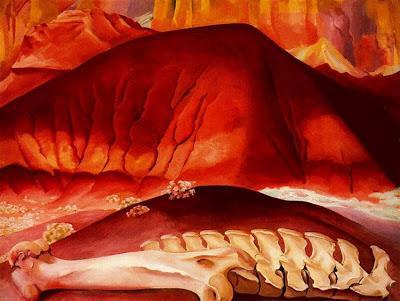
Red Hills and Bones by George O'Keeffe
When we talk about bones and/or joints, we are referring to the body’s skeletal system. The skeletal system is comprises of all the bones and joints in the body provides structural support and serves as a storehouse for calcium and phosphate. Different kinds of cells, proteins, and minerals make up the skeletal system to act as a scaffold by providing support and protection to the softer tissues of the body and also attachment points for muscles to allow movements at the joints. Up until now it was assumed that the skeletal system was an inert calcified structure that only provided structural framework to prevent the body from collapsing. But thanks to some recent groundbreaking work (see The contribution of bone to whole-organism physiology), we now know that there’s more to the bones than just the support structure.Endocrine organs secrete hormones directly into the blood stream to be carried to distant target organs. Examples of endocrine organs include the hypothalamus, pituitary, thyroid, parathyroid, adrenals, pineal body, and the reproductive organs (ovaries and testes). Recent research studies now point to the skeleton as an endocrine organ that secretes the endocrine hormone osteocalcin. Osteocalcin, which is found at high concentrations in the skeleton, was thought to be primarily involved in bone-building, bone mineralization, and maintaining calcium ion levels. Researchers now believe that osteocalcin acts as a hormone and travels to distant organs including the pancreas to release more insulin, to the adipose tissue to stimulate the release of another hormone adiponectin, which also regulates insulin levels, and the testes for testosterone production. Thus, the bone has now emerged as a genuine endocrine gland (see The "soft" side of the bone: unveiling its endocrine functions). Additionally, work by Gerard Karsenty, at the department of genetics and development at Columbia University Medical Center, reveals that osteocalcin has wide-ranging effects on liver, muscle, and, guess what, the brain as well (see Maternal and offspring pools of osteocalcin influence brain development and functions). Working with mice that had been engineered to lack osteocalcin, Karsenty noticed that while their skeletons appeared essentially normal, the mice appeared too docile, less rebellious, anxious, depressed, and displayed memory issues, suggesting that the bone via its hormone osteocalcin plays a direct role in memory and moods. When Karsenty infused these mice with osteocalcin, their moods improved and their performance on memory tests became normal. Furthermore, Karsenty also discovered that osteocalcin from pregnant mother mice crossed the placenta barrier and triggered the development and architecture of the mouse fetus’s brain. Simply put, bones communicated with the neurons and shaped the brain even before birth. This entire concept of bone-brain axis was least surprising to me because in Ayurveda, we are taught that the nervous system (brain and spinal cord—Majja Dhatu) arises from the precursor skeletal tissue (Asthi Dhatu). So as a researcher I was happy with the evidence-based research supporting this concept. So what might the bone-brain communication mean for human health? We know that as we age, our skeletal system degenerates as reflected in the reduction of bone mass. Additionally, aging also brings with it memory and cognitive loss and emotional turbulence. While all these changes were considered to be separate and independent effects of old age, taking into account Karsenty’s tantalizing work, it appears that these age-associated degenerative events in the physical body, emotional imbalance, and memory losses may actually be related and interconnected, and osteocalcin may be one of the molecules cementing these processes. Now I am sure you must be curious to know if we need to start taking osteocalcin to protect ourselves from age-associated skeletal degeneration or memory and cognitive decline. Remember, these kinds of questions can create false hopes, so before you sprint to the nearest pharmacy for a dose of synthetic osteocalcin, think of another attractive and natural alternative route to boost the bone-brain connection. Research studies show that the best thing to do to strengthen the bone and prevent age-related cognitive decline is exercise. Physical exercise helps partly because it works to maintain and strengthen the bones, which make more osteocalcin that in turn helps preserve memory and mood. And for us yogis, there is some exciting news as well. A recent research study showed that yoga increases bone turnover and triggers increased production of osteocalcin, which may help in the preserving bone mineral density (see Effects of Yoga on Bone Metabolism in Postmenopausal Women). While the authors of this study did not examine cognitive changes in these human subjects, I am guessing that given the ground-breaking studies by Gerard Karsenty, the osteocalcin production from the yoga regimen may help reverse cognitive changes.Thus, it appears that all the regions of the body are more closely networked and interconnected than most people think, and the brain cannot be delineated or excluded from the body (see Your Brain is More Than That Thing in Your Skull). Additionally, the above-mentioned studies also suggest that the concept of unidirectional information flow from the brain to the periphery is incorrect, and it appears that peripheral organs also talk to the brain, making the information flow bidirectional (brian-body-brain). In addition to the different areas of the body communicating to the brain, we now also have a better understanding of how the bone talks to the brain and fosters its development, and how yoga can strengthen the bone-brain nexus. Let’s just say that an additional path to the brain starts from the bone!Subscribe to Yoga for Healthy Aging by Email ° Follow Yoga for Healthy Aging on Facebook ° Join this site with Google Friend Connect
